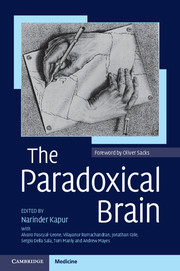Book contents
- Frontmatter
- Contents
- Acknowledgements
- Preface
- Foreword
- Author affiliations
- Abbreviations
- 1 The paradoxical nature of nature
- 2 Paradoxical effects of sensory loss
- 3 Paradoxical functional facilitation and recovery in neurological and psychiatric conditions
- 4 Paradoxes in neurorehabilitation
- 5 The paradoxical self
- 6 Paradoxical psychological functioning in early child development
- 7 Cognitive ageing: a positive perspective
- 8 Paradoxes of learning and memory
- 9 The paradox of human expertise: why experts get it wrong
- 10 Paradoxes in Parkinson's disease and other movement disorders
- 11 Paradoxical phenomena in epilepsy
- 12 Paradoxical creativity and adjustment in neurological conditions
- 13 Paradoxical functional facilitation with noninvasive brain stimulation
- 14 Unexpected benefits of allergies and cigarette smoking: two examples of paradox in neuroepidemiology
- 15 The paradox of autism: why does disability sometimes give rise to talent?
- 16 Paradoxes in creativity and psychiatric conditions
- 17 The paradox of psychosurgery to treat mental disorders
- 18 The paradox of electroconvulsive therapy
- 19 Paradoxes of comparative cognition
- 20 Paradoxical phenomena in brain plasticity
- 21 Immature neurons in the adult brain. Breaking all the rules
- 22 The paradoxical hippocampus: when forgetting helps learning
- 23 Paradoxical effects of drugs on cognitive function: the neuropsychopharmacology of the dopamine and other neurotransmitter systems
- 24 The paradoxical brain – so what?
- Index
- References
21 - Immature neurons in the adult brain. Breaking all the rules
Published online by Cambridge University Press: 05 December 2011
- Frontmatter
- Contents
- Acknowledgements
- Preface
- Foreword
- Author affiliations
- Abbreviations
- 1 The paradoxical nature of nature
- 2 Paradoxical effects of sensory loss
- 3 Paradoxical functional facilitation and recovery in neurological and psychiatric conditions
- 4 Paradoxes in neurorehabilitation
- 5 The paradoxical self
- 6 Paradoxical psychological functioning in early child development
- 7 Cognitive ageing: a positive perspective
- 8 Paradoxes of learning and memory
- 9 The paradox of human expertise: why experts get it wrong
- 10 Paradoxes in Parkinson's disease and other movement disorders
- 11 Paradoxical phenomena in epilepsy
- 12 Paradoxical creativity and adjustment in neurological conditions
- 13 Paradoxical functional facilitation with noninvasive brain stimulation
- 14 Unexpected benefits of allergies and cigarette smoking: two examples of paradox in neuroepidemiology
- 15 The paradox of autism: why does disability sometimes give rise to talent?
- 16 Paradoxes in creativity and psychiatric conditions
- 17 The paradox of psychosurgery to treat mental disorders
- 18 The paradox of electroconvulsive therapy
- 19 Paradoxes of comparative cognition
- 20 Paradoxical phenomena in brain plasticity
- 21 Immature neurons in the adult brain. Breaking all the rules
- 22 The paradoxical hippocampus: when forgetting helps learning
- 23 Paradoxical effects of drugs on cognitive function: the neuropsychopharmacology of the dopamine and other neurotransmitter systems
- 24 The paradoxical brain – so what?
- Index
- References
Summary
Summary
Paradoxes in the field of adult neurogenesis are many. This may be partly due to the fact that this field of research is relatively new and that ideas outpace hard facts. Moreover, evidence originating from different laboratories is often inconsistent due to varied experimental conditions. We will not concern ourselves with such trivial controversies, but instead try to point out the perceived inconsistencies that may represent true exceptions to the rule. Such paradoxes make one pause and wonder about accepted theories, and importantly, may point us in new and creative directions.
The chapter begins with an explanation of neurogenesis in the context of brain anatomy. Description of neuronal ‘assembly line’ is followed by explanation of what new neurons look like and how they function. At the end of this chapter the reader will realize that the very existence of adult neurogenesis is still denied by some, and that most debates are yet to be settled.
Glossary
Apoptosis – a type of cell death resulting from a sequence of chemical reactions within the cell. It can be triggered ‘on purpose’ to eliminate excessive cell numbers during brain growth.
Contextual learning – a type of learning depending strongly on the context in which the learning took place. Often associated with specific brain structures such as the hippocampus.
Entorhinal cortex – part of the cortex immediately adjacent to the hippocampus. It contains neurons that send information to and receive information from the hippocampus.
Hippocampal formation – includes three main brain components constituting neuronal circuitry responsible for learning.
- Type
- Chapter
- Information
- The Paradoxical Brain , pp. 365 - 378Publisher: Cambridge University PressPrint publication year: 2011



